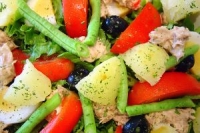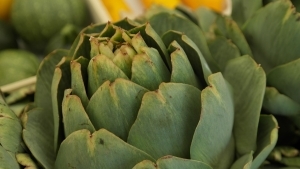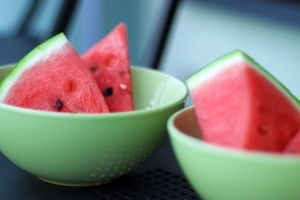Howick Christmas Cake
Adapted from 'Howick Christmas Cake', first published in Aunt Daisy's Book of Selected Special Recipes From California, Canada, France, Australia and New Zealand (1935).
At the time when this cake was popular, the jam that distinguishes the recipe would have been homemade. It was economical to use up the jam from the last season or from even older batches. Homemade jam contains less sugar than the purchased product. If blackcurrant jam has to be bought for this recipe choose a quality product and compare sugar contents.
.jpg) Ingredients
Ingredients
- 450 g bread flour
- 340 g raisins
- 340 g sultanas
- 340 g currants
- 225 g peel
- 225 g crystallised ginger, chopped
- 115 g walnuts, chopped
- 115 g almonds, chopped (no need to skin)
- 340 g butter
- 340 g sugar
- 6 eggs
- 1/2 teaspoon salt
- 1 teaspoon baking soda
- 2 tablespoons treacle
- 1 cup black currant jam
Method
Prepare a 25 cm diameter-round pan or 23 cm-square pan by lining with a double layer of brown paper and a single layer of baking paper. Preheat the oven to 130˚C with a shelf in the middle or slightly below.
Weigh the flour and set aside. In a large bowl place the raisins, sultanas, currants, peel, ginger, walnuts and almonds. Add 2 tablespoons of the weighed flour and stir through, separating any clumps of dried fruit.
Soften the butter in a large bowl and cream with the sugar until light and fluffy. In another bowl beat the eggs until foamy. Add to the creamed mixture a little at a time and continue beating. If the mixture shows signs of curdling add a spoonful or two from the weighed flour. Beat well. Sift the remaining weighed flour with the salt and baking soda. Fold into the creamed mixture.
Add the treacle and jam to the fruit and stir to mix thoroughly. Lastly add the creamed mixture and fold through gently but thoroughly.
Spoon into the prepared cake pan. Smooth the surface with a wet hand. Place in the oven and bake for 4 to 4 1/2 hours. (Details on how to test when a cake is cooked are given below.) Remove from the oven, cover with a teatowel and leave in the pan until cold. Turn out on to a rack or tray. Remove brown paper and baking paper. Wrap in greaseproof paper and store in an airtight cake container or wrap in foil.
Hint
During the cooking check that the surface of the cake is not browning too much and if so cover with a double piece of baking paper. Bake the cake for the shorter time specified in the recipe and test for doneness. When cooked, a cake will have shrunk slightly from the sides of the cake pan, the middle will be firm when gently pushed at the centre and the colour will have darkened. If these criteria are met then use a warm skewer or wire cake tester to insert into the middle of the cake. It should come out with no uncooked mixture adhering to it. If necessary, continue to bake for another 10–15 minutes and test again.


